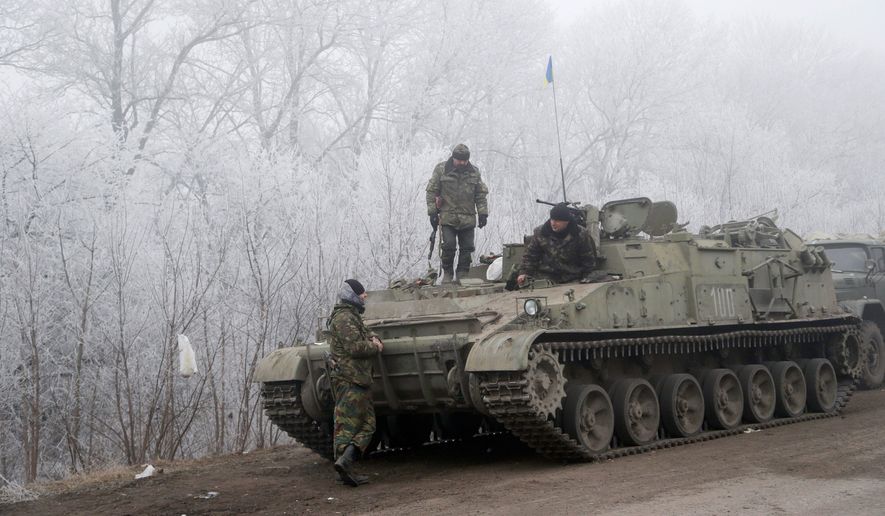Continued fighting Sunday around a key transport hub in eastern Ukraine threatened to derail the delicate cease-fire that went into effect over the weekend between Ukraine’s military and Russian-backed separatists.
However, European leaders noted that the guns had gone silent in most other areas of the nation and expressed hope for the truce to hold.
The cease-fire was slated to go into effect at midnight Saturday. But late Sunday afternoon, Ukrainian military sources said their troops were still under increasing fire near Debaltseve, a railway junction town where a top separatist commander reportedly said the cease-fire was irrelevant.
In Washington, the Obama administration stayed notably quiet Saturday and Sunday about the prospects for the fragile peace deal and cease-fire plan that was hammered out last week — without direct U.S. participation — by the leaders of Russia, Ukraine, Germany and France in hopes of ending a war that has killed more than 5,300 people in eastern Ukraine.
The White House welcomed the peace deal Thursday, but administration officials said Friday that they were still considering sending U.S. weapons to Ukraine’s military, a decision that would depend in part on the success or failure of the cease-fire.
At the State Department, officials said they were keeping a particularly close eye on Debaltseve. Hours before the cease-fire was to take hold, the department began circulating a series of satellite photos to reporters claiming to show heavy Russian military equipment near the town.
PHOTOS: Top 10 U.S. fighter jets
The photos provide “credible evidence that lead to the conclusion that the Russian military has deployed large amounts of artillery and multiple rocket launchers around Debaltseve,” department spokeswoman Jennifer Psaki said in a statement. “We are confident that these are Russian military, not separatist systems.”
Although pro-Russia rebels signed the cease-fire deal, the status of Debaltseve was not entirely clear because the town sits along territory claimed both by the rebels and the Ukrainian military.
The fighting there Sunday suggested that Moscow may be bent on using force to control Debaltseve, even while honoring the cease-fire elsewhere in eastern Ukraine.
Reuters reported that pro-Russia rebels announced that they would not observe the truce at Debaltseve.
“Of course we can open fire [on Debaltseve]. It is our territory,” senior rebel commander Eduard Basurin told the news agency. “The territory is internal: ours. And internal is internal. But along the line of confrontation there is no shooting.”
Around the same time Sunday, the office of French President Francios Hollande asserted that his government, along with that of Germany, believed the cease-fire was “generally” being observed elsewhere in eastern Ukraine.
According to the BBC, the statement acknowledged “local incidents” of continued shooting that must be resolved quickly.
Teams of observers from the Organization for Security and Cooperation in Europe are slated to monitor the progress of the cease-fire in the coming days.
The OSCE dispatched 20 patrols Sunday, but the head of the monitoring mission said pro-Russia rebels were blocking their access to Debaltseve, according to The Associated Press.
Separately, there was skepticism on the ground about whether the cease-fire would hold in other areas.
Maxim, a rebel guerrilla at a checkpoint on a road heading from the separatist-held eastern Ukrainian city of Donetsk to the Ukrainian government-held city of Dnipropetrovsk, predicted that the halt in shooting would last only a few days.
“Truce? I doubt it. Maybe two to three days, and then they will start shooting again,” he told Reuters. “This is all for show. The OSCE is driving around here, so of course they are being quiet.”
Heading into the cease-fire, the Obama administration offered guarded comments of hope.
“The proof will be in the pudding,” White House Chief of Staff Denis McDonough told CBS in an interview recorded Saturday. “The Russians have a lot to account for here, and we will see exactly what happens here. [I’m] not optimistic or pessimistic. I’m just realistic about this.”
The administration has faced criticism from Republicans and some Democrats for not taking a more aggressive posture. Questions have been raised about the absence of any U.S. official in the room last week when the cease-fire plan was hammered out in Minsk, Belarus.
The Los Angeles Times reported Friday that administration officials cited two main reasons. First, they are trying to avoid the perceptions of a Cold War-style, U.S.-Russian confrontation in Ukraine, because Russian President Vladimir Putin claims the conflict was fomented by Washington’s desire to draw the nation into its security orbit. Second, the White House wants Western European nations — several of which have cut their overall defense spending during recent years — to step up and take the lead in resolving what many in Washington see as a primarily European security problem.
The administration also claims it is playing a far more aggressive role than reports suggest.
“It would be inappropriate or a misperception to say that we have not been in the game,” one senior administration official told reporters during a background call last week.
The official pointed to regular and direct contact that President Obama and Vice President Joseph R. Biden have had with Ukrainian President Petro Poroshenko and that Mr. Obama has had with Russian President Vladimir Putin.
The official also noted that German Chancellor Angela Merkel had been in Washington and engaged in “a very intense set of meetings” with the Obama administration just days before heading to Minsk, where the cease-fire deal was reached.
“We were [also] directly engaged with the Europeans right through the night in Minsk,” the official added. “So I think it’s safe to say that the United States has been present and accounted for right through the process.”
• Guy Taylor can be reached at gtaylor@washingtontimes.com.




Please read our comment policy before commenting.